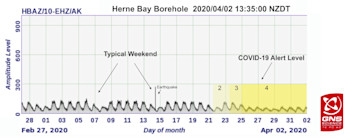
Volcano Monitoring Network ‘senses’ Auckland city’s COVID-19 response
The Auckland Volcano Seismic Network has detected the slowdown of Auckland city in response to the COVID-19 lock down. The seismic noise is at levels usually seen on a Sunday, just one of the interesting signals we can see from our seismic data.
GeoNet operates a network of seismometers in, and around Auckland City as part of our National Volcano Monitoring System. The network of 11 instruments is designed to pick up early signs of volcanic unrest in the Auckland Volcanic Field.
Cities create their own seismic noise, mostly from vehicles, and this seismic signal can mask the shaking caused by real earthquakes. This can make the detection of small earthquakes that happen close to cities quite difficult. We get around that by placing our sensors deep below the surface (up to 380 metres down), rather than at the surface (which is where most of our national network sits). This means much of the noise created by the city vanishes.
Interestingly though, volcanoes when in unrest can also develop a lot of noise from underground volcanic process so we need a technique to analyse this noise signal, this is where RSAM comes in. RSAM stands for Real-time Seismic Amplitude Measurement, it represents the overall signal size over periods of 10 minutes. Sometimes when there are a large number of earthquakes, or the level of volcanic tremor is high, the visual drums can be difficult to use. RSAM is really valuable tool and is an excellent way of showing changes with time. For example, we can also see interesting trends from the outputs of noisy sites (like those near a city or coast). It allows us to see the daily commuting cycle around the city, the decrease of noise on the weekends, and even the size of the sea swells from the Tasman Sea.
As the country started to #StayHomeNZ to help eliminate the spread of COVID-19 we recorded a significant decrease in noise about Auckland city by our seismometers. In the attached plot we are looking at the signal from the borehole sensor at Herne Bay in the city, this borehole is our deepest at 380m deep. In the RSAM plot for the last month (below) you can see the normal weekly cycle of the city, busy Monday to Friday, a slowdown in the afternoon on Saturday and quietest on Sunday. And last week we could see the city start to slow down on Tuesday-Wednesday when New Zealand went to COVID-19 Alert Level 4. It has been at typical weekend levels since then.
So, it’s great to see people staying at home as this is the best thing we can all do to stop the spread of COVID-19. And while it is normal to feel stressed or lonely when self-isolating, there are some things you can do to feel better, please visit the COVID-19 website for some great ideas to look after your mental wellbeing.
Attributable to: Brad Scott, GNS Science Volcanologist Media Contact: 021 574 541 or media@gns.cri.nz


